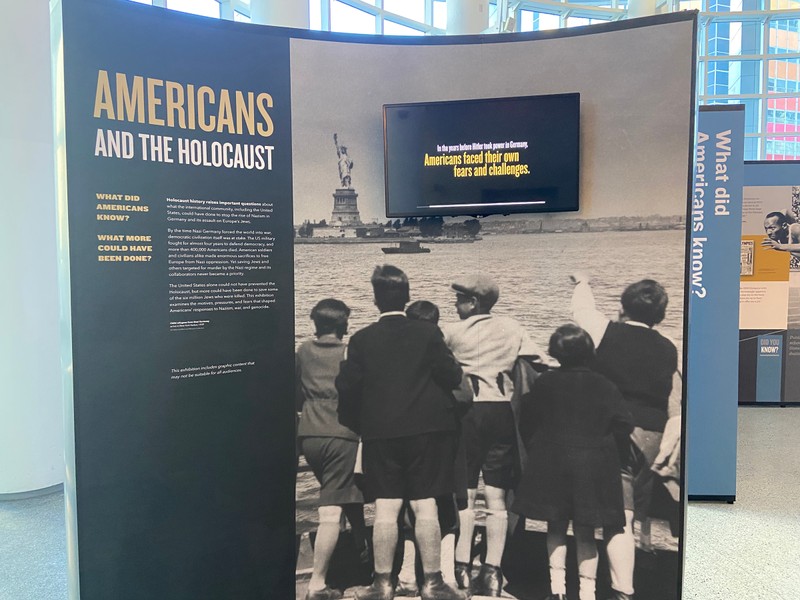Intro Panel (Americans and the Holocaust Exhibit)
Introduction
Text-to-speech Audio
This exhibition asks two main questions: what did Americans know about the Holocaust? The Museum answers this in the exhibition. What more could have been done? This is for you to discuss and debate. The exhibition is divided into four sections exploring these themes, each section asking a specific question: What did Americans know? Did Americans help refugees? Why did Americans go to war? And how did Americans respond to the Holocaust? In order to contextualize American responses, it is important to understand what the United States looked like before 1933, the year that Adolf Hitler was appointed chancellor of Germany and Franklin Roosevelt became president of the United States.
Please watch the large screen on the title panel of the exhibition.
Based on what you saw in the video, what concerns and fears dominated the American mindset from 1918-1933? The United States was isolationist after World War I, with many Americans believing that the country should not engage in any foreign wars. Congress passed new immigration laws in the 1920s that limited the number of immigrants who could come to the United States. Americans were worried about communism, and many believed that Jews were linked with communism. Our country was also segregated by race in many places, legally and by custom in others. And in 1929, the Great Depression began. Millions of Americans were out of work and lost their life savings. The Depression was still going on when President Roosevelt took office in 1933.
Images
Intro Panel of the Americans and the Holocaust exhibit

Backstory and Context
Author-Uploaded Audio
Listen to a narration of this entry's description by Larry Johnson.
Text-to-speech Audio
Metropolitan Library System is one of 50 U.S. libraries selected to host AMERICANS AND THE HOLOCAUST, a traveling exhibition from the U.S. Holocaust Memorial Museum that examines the motives, pressures, and fears that shaped Americans’ responses to Nazism, war, and genocide in Europe during the 1930s and 1940s.
The Americans and the Holocaust exhibit will be on display at the Dowtown Library, along with a series of related special events from Thursday, January 5 to Sunday, February 12.
Based on extensive new research of that period, Americans and the Holocaust addresses important themes in American history, exploring the many factors — including the Great Depression, isolationism, xenophobia, racism, and antisemitism — that influenced decisions made by the U.S. government, the news media, organizations and individuals as they responded to Nazism. This exhibition will challenge the commonly held assumptions that Americans knew little and did nothing about the Nazi persecution and murder of Jews as the Holocaust unfolded.
Drawing on a remarkable collection of primary sources from the 1930s and ’40s, the exhibition focuses on the stories of individuals and groups of Americans who took action in response to Nazism. It will challenge visitors to consider the responsibilities and obstacles faced by individuals — from Franklin Delano Roosevelt to ordinary Americans — who made difficult choices, sought to effect change, and, in a few cases, took significant risks to help victims of Nazism even as rescue never became a government priority.
Americans and the Holocaust was made possible by the generous support of lead sponsor Jeannie & Jonathan Lavine. Additional major funding was provided by the Bildners — Joan & Allen z”l, Elisa Spungen & Rob, Nancy & Jim; and Jane and Daniel Och. The Museum's exhibitions are also supported by the Lester Robbins and Sheila Johnson Robbins Traveling and Special Exhibitions Fund, established in 1990.
